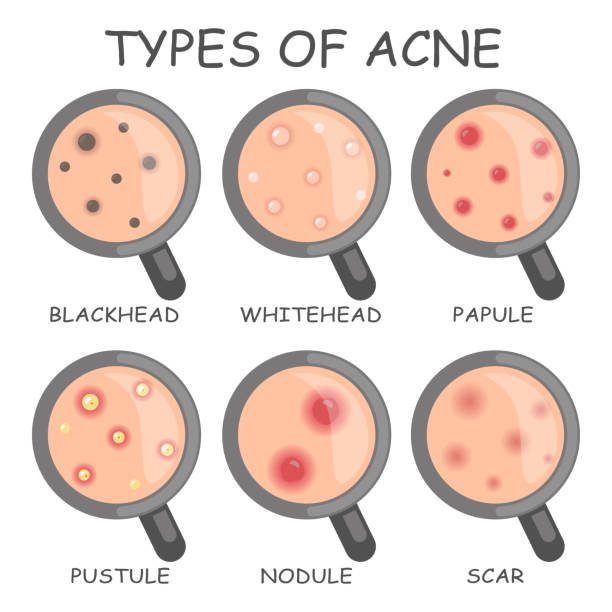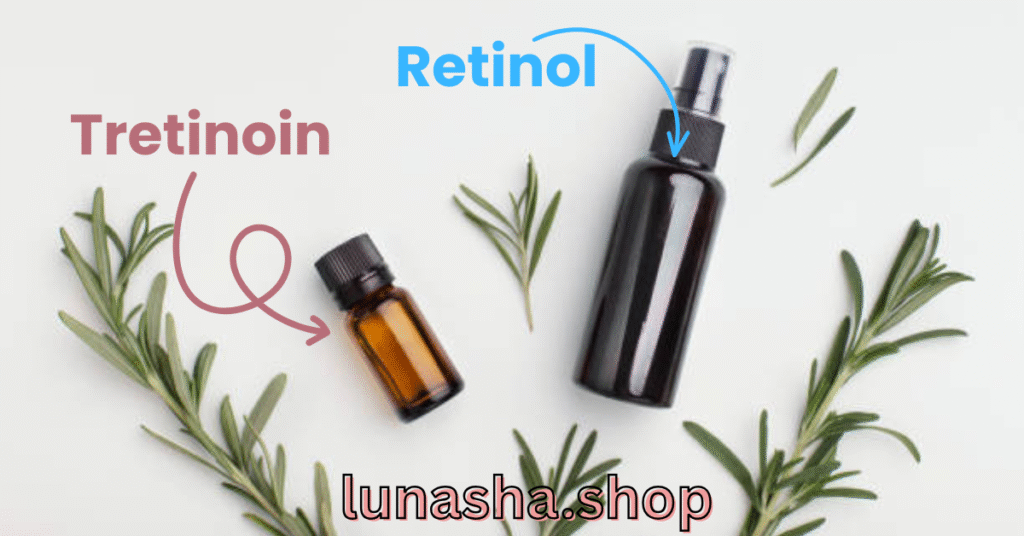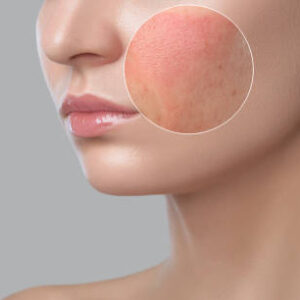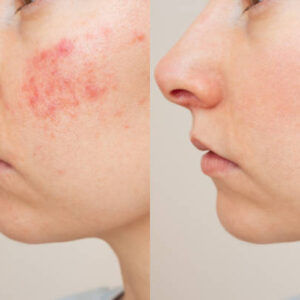Tretinoin vs Retinol
The Night I Almost Gave Up on My Skin
I remember staring at my reflection in the bathroom mirror at 2 AM, exhausted from another failed attempt at covering up my acne scars with concealer. I’d been dealing with post-inflammatory hyperpigmentation and those stubborn pitted scars for over three years, and honestly? I was ready to throw in the towel.
That’s when my dermatologist dropped the tretinoin vs retinol bomb on me. “Look,” she said, “you’ve been playing with over-the-counter retinol for months. It’s time we talked about the real deal.” And boy, was she right. The tretinoin vs retinol debate isn’t just about fancy skincare terminology – it’s about results that actually matter.
After using both tretinoin and retinol for acne scars over the past two years, I’ve learned some hard truths about what really works. Spoiler alert: the stronger option isn’t always better for everyone, and timing is everything when it comes to treating acne scars.
What Are Acne Scars and Why They’re So Stubborn
Before diving into the tretinoin vs retinol showdown, let’s get real about what we’re actually fighting. Acne scars aren’t just “marks” that fade over time – they’re permanent changes to your skin’s structure. When I first started dealing with scarring, I thought those dark spots would just disappear if I waited long enough. Wrong.
There are two main types of acne scarring that tretinoin and retinol can help with. Post-inflammatory hyperpigmentation (PIH) appears as dark spots where acne used to be, while atrophic scars are the actual indented marks that create texture issues. The tretinoin vs retinol effectiveness really depends on which type you’re dealing with.

The reason acne scars are so persistent comes down to collagen damage. When your skin gets inflamed from acne, it either produces too much collagen (creating raised scars) or too little (creating pitted scars). This is where tretinoin vs retinol treatments come in – they work by encouraging healthy collagen production and speeding up cell turnover.
What frustrated me most was learning that waiting too long to treat scars makes them harder to improve. Fresh scars respond better to treatment than old ones, which is why starting a tretinoin or retinol routine early is crucial for acne scar treatment.
Understanding Retinol: The Gentle Giant
Let me start with retinol since that’s where most people begin their anti-aging and acne scar journey. Retinol is basically the gentler cousin in the retinoid family, and it’s available over-the-counter without a prescription. When I first started using retinol for acne scars, I thought I was being smart by easing into the tretinoin vs retinol world gradually.
Retinol works by converting to retinoic acid in your skin, but here’s the catch – it has to go through several conversion steps before it becomes active. This means it’s significantly weaker than prescription tretinoin, which is already in its active form. Think of it like comparing a gentle stream to a powerful river – both can carve through rock, but one takes a lot longer.
The biggest advantage of retinol is its tolerance factor. When I started with a 0.25% retinol serum, I experienced minimal irritation compared to my later tretinoin experience. This makes retinol perfect for beginners who want to test the waters of retinoid therapy without diving into the deep end.
However, here’s where the tretinoin vs retinol debate gets interesting for acne scars specifically. While retinol can definitely help with post-inflammatory hyperpigmentation and mild texture issues, it’s not powerful enough to make significant changes to deeper acne scars. I used retinol consistently for eight months and saw maybe 15-20% improvement in my PIH, but those pitted scars? Barely budged.
The concentration game with retinol is also tricky. Most over-the-counter products contain 0.25% to 1% retinol, and even the highest concentrations pale in comparison to prescription tretinoin. This is why many dermatologists view retinol as a stepping stone rather than a final destination for serious acne scar treatment.
Why I Made the Switch to Tretinoin
After months of mediocre results with retinol, my dermatologist suggested we level up to tretinoin. “It’s time to stop playing around,” she said, and honestly, I was ready for the big guns. The tretinoin vs retinol potency difference is significant – tretinoin is essentially 20 times stronger than retinol.
Tretinoin, also known as Retin-A, is prescription-only retinoic acid. Unlike retinol, which needs to convert to its active form, tretinoin is already the active ingredient your skin cells recognize. This means faster results but also more potential for irritation, especially during the initial adjustment period.
The decision to switch from retinol to tretinoin wasn’t taken lightly. My dermatologist explained that tretinoin is the gold standard for acne scar treatment because it directly stimulates collagen production and dramatically increases cell turnover. We’re talking about new skin cells reaching the surface every 14 days instead of the typical 28-day cycle.
What really sold me on tretinoin was the research backing it up. Studies show that tretinoin can improve acne scars by up to 79% when used consistently, particularly for icepick scars and newer scarring, some even claiming anti-aging let’s keep it for later. The tretinoin vs retinol effectiveness for acne scars isn’t even close – tretinoin wins hands down.
But here’s the real talk – tretinoin isn’t for everyone. The “tretinoin uglies” or purging phase can last 6-12 weeks, during which your skin might look worse before it gets better. This is where the tretinoin vs retinol tolerance factor becomes crucial in decision-making.
My 6-Month Tretinoin Journey: The Real Story
Starting tretinoin was like jumping into a cold pool – shocking at first, but eventually refreshing. My dermatologist prescribed 0.025% tretinoin cream, which is the lowest concentration available. Even so, my skin went through what I can only describe as a rebellion.
Week 1-2: The honeymoon phase. My skin felt smoother, and I was convinced I’d found the holy grail of acne scar treatment. The tretinoin vs retinol difference was immediately apparent – my skin felt like it was actually doing something rather than just sitting there.
Week 3-8: Welcome to purge city. My skin broke out in places I’d never had acne before, and the peeling was intense. I’m talking about skin flaking off like a sunburn. This is where many people give up, but my dermatologist warned me this was normal. The tretinoin was bringing all the underlying congestion to the surface.
Week 9-12: The turning point. The breakouts started calming down, and I began seeing real improvement in my post-inflammatory hyperpigmentation. Those dark spots that had been haunting me for years were finally fading. This is when I really understood the tretinoin vs retinol power difference.
Week 13-20: Steady improvement. My pitted acne scars were becoming less noticeable, and my overall skin texture was smoothing out. The tretinoin was working its magic on collagen production, and I could actually see the difference in photos.
Week 21-24: The results phase. By month six, my acne scars had improved by about 60-70%. The transformation was dramatic enough that people started commenting on my skin. This is when I became a true believer in tretinoin for acne scars.
The key to my success was consistency and patience. I used tretinoin every other night initially, then gradually increased to nightly use. The tretinoin vs retinol timeline is drastically different – where retinol might take 6-12 months to show results, tretinoin delivered noticeable improvements in just 3-4 months.
Before and After: The Honest Results
Let me be brutally honest about my before and after tretinoin results because I think a lot of people set unrealistic expectations. I didn’t go from crater-face to porcelain doll overnight, but the improvement was significant enough to boost my confidence dramatically.
Before tretinoin, I had about 15-20 noticeable pitted scars on my cheeks and jawline, plus extensive post-inflammatory hyperpigmentation. My skin texture was rough and uneven, and I couldn’t leave the house without foundation. The tretinoin vs retinol debate was academic to me because retinol simply wasn’t cutting it.
After six months of consistent tretinoin use, about 70% of my PIH had faded, and the depth of my pitted scars had decreased noticeably. More importantly, my skin texture had improved dramatically. I could actually wear tinted moisturizer instead of full coverage foundation, which was a game-changer for my self-esteem.
The most significant change was in my icepick scars, which responded better to tretinoin than my broader boxcar scars. This aligns with research showing that tretinoin is most effective on narrow, deeper scars rather than wide, shallow ones.
However, I want to be clear about expectations. Tretinoin isn’t a miracle worker – it’s a long-term investment in your skin health. The tretinoin vs retinol results difference is significant, but neither option will completely eliminate deep acne scars. For those, you’d need professional treatments like chemical peels or microneedling.
What surprised me most was how tretinoin improved my overall skin quality beyond just scar treatment. My pores looked smaller, my skin tone was more even, and I even noticed some improvement in fine lines. This is where the tretinoin vs retinol anti-aging benefits really shine through.
The Pros and Cons: What Nobody Tells You
After using both retinol and tretinoin for acne scars, I’ve learned that each has its place in skincare. The tretinoin vs retinol decision isn’t always straightforward, and what works for one person might not work for another.
Tretinoin Pros:
- Dramatic results for acne scars, especially PIH and shallow pitted scars
- Fast-acting compared to retinol – visible results in 3-4 months
- Gold standard treatment recommended by dermatologists
- Multiple benefits beyond acne scars, including anti-aging effects
- Backed by extensive research and clinical studies
Tretinoin Cons:
- Requires prescription and dermatologist supervision
- Intense purging phase that can last 2-3 months
- Significant irritation, especially during initial adjustment
- More expensive than over-the-counter retinol options
- Can cause photosensitivity, requiring diligent sun protection
Retinol Pros:
- Gentler introduction to retinoid therapy
- Available over-the-counter without prescription
- Minimal irritation for most people
- Good for sensitive skin types
- Gradual improvement with less dramatic side effects
Retinol Cons:
- Slow results – can take 6-12 months to see significant improvement
- Limited effectiveness for deep acne scars
- Weaker formulation may not address severe scarring
- Requires higher concentrations for meaningful results
- May not be cost-effective in the long run
The tretinoin vs retinol tolerance factor is huge. If you have sensitive skin or are just starting your acne scar treatment journey, retinol might be the better choice initially. But if you’re dealing with significant scarring and want faster results, tretinoin is worth the adjustment period.
Finding Your Perfect Routine: My Current Regimen
After two years of trial and error, I’ve found the sweet spot in my tretinoin routine. The tretinoin vs retinol integration doesn’t have to be an either-or decision – you can actually use both strategically.
My current routine starts with a gentle, non-comedogenic cleanser every morning and night. I learned the hard way that harsh cleansers and tretinoin don’t mix. The combination left my skin barrier compromised and made the tretinoin irritation worse.
For morning skincare, I use a vitamin C serum, followed by a lightweight moisturizer with hyaluronic acid, and always finish with broad-spectrum SPF 30 or higher. The tretinoin makes your skin more photosensitive, so sun protection isn’t optional – it’s mandatory.
Evening routine is where the magic happens. I apply tretinoin 0.05% (my dermatologist increased my concentration after the initial six months) every other night, alternating with a gentle retinol serum on off-nights. This tretinoin vs retinol combination approach helps maintain consistent retinoid activity while giving my skin breaks from the intense tretinoin.

The key is moisturizing strategically. I use a thick, occlusive moisturizer on tretinoin nights, sometimes even applying it before the tretinoin to buffer the intensity. This technique, called “tretinoin sandwich,” has been a game-changer for my skin tolerance.
I also incorporate niacinamide serum twice a week, which helps with post-inflammatory hyperpigmentation and supports the tretinoin’s effects. The tretinoin vs retinol routine can be enhanced with complementary ingredients that address different aspects of acne scarring.
Who Should Choose Tretinoin vs Retinol
The tretinoin vs retinol decision ultimately depends on your skin type, scar severity, and lifestyle factors. After helping several friends navigate this choice, I’ve identified some clear patterns for who benefits most from each option.
Choose Tretinoin if you:
- Have moderate to severe acne scarring
- Want faster results and are willing to endure the adjustment period
- Have tried retinol without satisfactory results
- Are committed to a long-term skincare routine
- Can handle the initial purging and irritation phase
- Have access to dermatological supervision
Choose Retinol if you:
- Have mild acne scarring or primarily PIH
- Have sensitive skin that reacts poorly to strong actives
- Prefer gradual improvement over dramatic changes
- Are new to retinoid therapy
- Want to avoid the prescription process
- Have budget constraints
The tretinoin vs retinol age factor is also worth considering. Younger skin typically tolerates tretinoin better, while mature skin might benefit from starting with retinol and gradually increasing potency. I started tretinoin at 28, and my skin’s resilience definitely worked in my favor.
Skin type plays a huge role too. Oily skin generally handles tretinoin better than dry or combination skin. If you’re dealing with both acne and anti-aging concerns, tretinoin offers more comprehensive benefits than retinol alone.
Pregnancy and breastfeeding are absolute contraindications for tretinoin, making retinol the safer choice for women in these situations. Always consult with a dermatologist before starting any retinoid therapy, especially if you have underlying skin conditions.
Where to Get Started and What to Expect
If you’re ready to join the tretinoin vs retinol battle against acne scars, here’s your roadmap to success. The journey starts with realistic expectations and professional guidance.
For tretinoin, you’ll need to see a dermatologist or use a telehealth service like Curology, Apostrophe, or Nurx. These platforms make accessing prescription tretinoin much easier than traditional dermatology appointments. Costs typically range from $15-50 per month, depending on your insurance and the service you choose.
Generic tretinoin is usually the most affordable option, while brand names like Retin-A or Renova cost more. The tretinoin vs retinol price difference is significant initially, but tretinoin’s effectiveness often makes it more cost-effective long-term.
For retinol, start with established brands like The Ordinary, Paula’s Choice, or Neutrogena. Begin with 0.25% concentration and gradually increase as your skin tolerates it. The tretinoin vs retinol accessibility factor heavily favors retinol since it’s available at most drugstores.
Here’s what to expect timeline-wise:
- Retinol: 3-6 months for initial results, 6-12 months for significant improvement
- Tretinoin: 6-12 weeks for initial results, 3-6 months for significant improvement
The tretinoin vs retinol commitment level is different too. Retinol requires patience and consistency, while tretinoin demands dedication through the difficult adjustment period. Both require religious sun protection to prevent further pigmentation.
My Personal Recommendations Based on Real Experience
After extensive experience with both tretinoin and retinol for acne scars, here’s my honest assessment of the tretinoin vs retinol debate. For mild acne scarring and post-inflammatory hyperpigmentation, retinol can be effective if you’re patient and consistent. I recommend starting with The Ordinary’s Retinol 0.2% in Squalane or Paula’s Choice Clinical 0.3% Retinol Serum.
However, if you’re dealing with moderate to severe acne scarring, don’t waste time with retinol. Go straight to a dermatologist for tretinoin. The tretinoin vs retinol effectiveness gap is too significant to ignore when you’re dealing with stubborn scarring.
For beginners, I suggest this approach: try retinol for 3-4 months. If you’re not seeing meaningful improvement, it’s time to level up to tretinoin. The tretinoin vs retinol transition is easier when you’ve already built some retinoid tolerance.
Budget-wise, tretinoin might seem more expensive upfront, but it’s more cost-effective long-term. I spent over $300 on various retinol products before switching to tretinoin, which costs me about $25 per month. The tretinoin vs retinol value proposition heavily favors tretinoin for serious acne scar treatment.
My biggest regret is not starting tretinoin sooner. The tretinoin vs retinol time investment is significantly different, and those extra months of retinol use could have been spent seeing real results with tretinoin instead.
Final Thoughts: The Verdict on Tretinoin vs Retinol
The tretinoin vs retinol debate for acne scars isn’t really a debate at all – it’s about matching the right treatment to your specific needs and circumstances. After two years of using both, I can confidently say that tretinoin is the superior choice for anyone serious about improving acne scars.
The science backs this up, my personal experience confirms it, and every dermatologist I’ve consulted agrees. Tretinoin’s ability to stimulate collagen production, increase cell turnover, and improve skin texture makes it the gold standard for acne scar treatment. The tretinoin vs retinol potency difference is simply too significant to ignore.
However, that doesn’t mean retinol is useless. For mild scarring, sensitive skin, or as a stepping stone to tretinoin, retinol has its place. The tretinoin vs retinol journey doesn’t have to be linear – you can start with retinol and progress to tretinoin as your skin adjusts.
What matters most is starting somewhere. Acne scars won’t improve on their own, and waiting only makes them harder to treat. Whether you choose tretinoin or retinol, consistency is key. The tretinoin vs retinol results both require patience and commitment.
If I could go back and give my scarred, frustrated self advice, it would be this: skip the endless research and product testing. Go see a dermatologist, get tretinoin, and stick with it through the adjustment period. The tretinoin vs retinol decision becomes crystal clear when you’re looking at dramatically improved skin six months later.
Remember, treating acne scars is a marathon, not a sprint. Both tretinoin and retinol require long-term commitment, but the confidence boost from clearer skin is worth every moment of the journey. Choose the option that fits your lifestyle and scar severity, but don’t let perfect be the enemy of good. Start somewhere, stay consistent, and give your skin the patience it deserves.
Frequently Asked Questions
Q: How long does tretinoin take to work on acne scars? A: Tretinoin typically shows initial results for acne scars within 6-12 weeks, with significant improvement visible after 3-6 months of consistent use. The timeline depends on scar severity and your skin’s response to treatment.
Q: Can I use tretinoin and retinol together? A: Yes, but alternating nights is recommended. Use tretinoin on some nights and retinol on others to maintain consistent retinoid activity while avoiding over-irritation. Always start slowly and monitor your skin’s response.
Q: Which is better for deep acne scars – tretinoin or retinol? A: Tretinoin is significantly more effective for deep acne scars due to its higher potency and direct action on collagen production. Retinol may help with surface-level scarring and PIH but lacks the strength needed for deeper indented scars.
Q: What’s the strongest retinol available without prescription? A: The strongest over-the-counter retinol is typically 1%, though even this concentration is much weaker than prescription tretinoin. Most people see better results with 0.5-1% retinol products from reputable brands.
Q: Does tretinoin make acne scars worse initially? A: Tretinoin can cause purging, which may temporarily make your skin look worse. This isn’t worsening of scars but rather the clearing of underlying congestion. The purging phase typically lasts 6-12 weeks before improvement becomes visible.
Q: Can pregnant women use retinol for acne scars? A: Retinol should be avoided during pregnancy and breastfeeding due to potential risks. Pregnant women should consult their healthcare provider about safe alternatives for treating acne scars during this time.
Q: How much does tretinoin cost compared to retinol? A: Tretinoin costs approximately $15-50 per month with prescription, while quality retinol products range from $10-80 per bottle. Long-term, tretinoin is often more cost-effective due to its superior results.
Q: What concentration of tretinoin is best for acne scars? A: Most people start with 0.025% tretinoin and gradually increase to 0.05% or 0.1% as tolerated. Higher concentrations aren’t necessarily better – consistency and proper use matter more than strength.
Q: Can tretinoin completely eliminate acne scars? A: Tretinoin can significantly improve acne scars, with studies showing up to 79% improvement in some cases. However, it rarely eliminates deep scars completely. Combining tretinoin with professional treatments often yields the best results.
Q: How long should I try retinol before switching to tretinoin? A: Give retinol at least 3-4 months of consistent use before evaluating its effectiveness. If you don’t see meaningful improvement in acne scars after this period, consider consulting a dermatologist about tretinoin.
The Ultimate Guide to Finding the Best Niacinamide Serum for Your Skin
The Serum That Changed My Life (And My Skin) I’ll be honest with you –…
Finding the Perfect Sunscreen for Sensitive Skin: My Journey from Reactions to Protection
sunscreen for sensitive skin I’ll never forget the day I realized my skin was basically…
How to Remove Acne Scars Naturally in a Week: My Journey from Hopeless to Radiant
How to Remove Acne Scars Naturally in 7 days I’ll be honest with you –…
Natural Remedies for Scars: My Journey to Healing Without Surgery
When Life Leaves Its Mark (And What I Learned About Healing) The scar on my…




